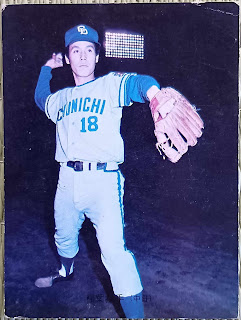Collecting and Translating the 1973 Calbee Bat-Backs (Part 12)
Happy New Year. Today’s entry marks the first time in a while the run is interrupted. #64 is the last Block 1 card I need and it has proven stubbornly elusive. Starting with that card, and ending with #72, Block 1 closes out with 9 cards (all featuring Chunichi Dragons players) that curiously come with or without player and team names on the front. Adding to this, cards #63 and #65 feature essentially the same blurb on the back, just slightly reworded. I don’t know the reason for these quirks, but they are part of what makes ‘73 Calbee one of the most endlessly absorbing baseball card sets in existence.
#61 Yamamoto (Ko) - Outfielder (Hiroshima)
Strong Throwing, Good Fielding, Good Hitting: Yamamoto (Ko)
Yamamoto was lauded, along with Hanshin’s Tabuchi, as a powerful hitting combo during their Hosei University days. With a .258 average last year, he is getting closer to .300 and is keen on being a step ahead of Tabuchi in becoming a three-hundred hitter. Yamamoto also has a cannon for an arm. He’ll catch an outfield fly and throw it back from center with such velocity that the ball won’t bounce even once on its way to the catcher’s mitt. It’s this long-toss ability and control that make him the number one outfielder in the Central League.
This supposed .300-average derby between Tabuchi and Yamamoto could be considered a draw, as both first achieved the mark in 1975, although Yamamoto’s superior average (.319 to Tabuchi’s .303) was good for a batting title. Yamamoto would go on to reach .300+ six more times in his career while Tabuchi never again would. Despite this, Yamamoto was not quite a .300 career hitter (.291).
#62 Mimura - Shortstop (Hiroshima)
The Definition of Effort ・ Mimura
Up until three years ago, Mimura didn’t stand out as a player, but last season he hit .308 and has suddenly made his presence known. This season too (as of 6/7) he is getting on well in the .320 range, good enough for 2nd place among the top 30 in batting. Mimura stands 173cm tall and weighs 70kg. Though not blessed with physical strength, he trains much more than others, and that strength is steadily coming along. Since claiming a regular starting spot for his efforts, he has grown into a mainstay. Hiroshima is now feared as “Mimura’s Team.”
#63 Inaba - Pitcher (Chunichi)
The Giant Killer! Inaba
Inaba is now Chunichi’s ace. Last year, his second in the pros, he made his mark at 20-11, and what’s more, was peerless against the Giants. He’s eager to once again become a man possessed come Giants game day, wearing the ace’s number 18 and hurling with an unreadable poker face. At 174cm and 67kg, his phyiscal strength is a point of concern, but he has been training regularly and has added muscle to his legs and core, providing more stability. Now he has his sights on back-to-back 20-win seasons.
In Japanese baseball, there is a tradition of ace pitchers often wearing the number 18. The reason is not definitively known, but it seems the practice probably has its origin around the late 1930s. Two players in particular, Tadashi Wakabayashi of the Tigers and Hiroshi Nakao of the Giants likely played a role in popularizing its use. Both Hall of Famers, they were among the best pitchers of their era, and both wore #18—likely by pure chance. Wakabayashi, the story goes, was issued #4 but refused it because of that number’s inauspicious connotation (one of its readings in Japanese, ‘shi’ is the same as ‘death’). He was then issued the next lowest available number, 18. Nakao was likely given it out of convention. In those days, players were generally assigned a number 1-29. The player who wore #18 before him, Hachiro Maekawa (himself not a pitcher of much note), had retired from baseball after the season before Nakao’s debut, making it sensible to simply slot him in with that vacant number. Although I could get more into this, all I will say is that I reject interpretations that the number itself had some special preexisting significance, as well as the idea that Wakabayashi alone started the trend.
#65 Inaba - Pitcher (Chunichi)
The Giant Killer! Inaba
Last season, Inaba’s second in the pros, was a big success at 20-11 and saw him promoted to Chunichi’s ace. Particularly against the Giants does he turn in peerless performances. That ace’s number 18 isn’t just for show. Inaba hurls it with an unreadable poker face. At 174cm, 67kg his physical strength is a point of concern, but thanks to intense training his legs and core have stabilized, and his fastball is getting stronger too. Consecutive 20-win seasons, go for it!
Mitsuo Inaba had an inconsistent career for the Dragons and Hankyu Braves. He didn’t achieve another 20-win season, consecutive or otherwise, but came close in 1977 with 17. That season, his first with the Braves, saw him post a career low in ERA (2.45).
#66 Yazawa - First Baseman (Chunichi)
A Challenger for the Batting Title, Yazawa
Glaring intensely at the opposing pitcher, his favorite bat raised and at the ready... It’s hard to find a hole in Yazawa’s batting form. He’ll show any pitch what he’s got. To right, to left, he’ll put it where he wants. While he has impressive achievements of which to be proud from his time as a leading hitter at Waseda University, he now finds himself in the thick of an intense battle with the Giants’ Oh for the batting crown. Yazawa, the unwavering third batter.
Although Oh ended up winning the batting title in ‘73, Yazawa did eek him out in career average—.302 to Oh’s .301.




















Comments
Post a Comment